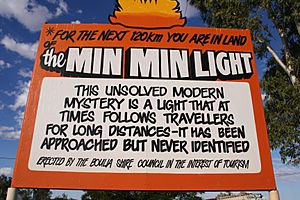Min Min light facts for kids
The Min Min light is a mysterious light often seen in the outback areas of Australia. People have reported seeing these strange lights for many years.
Contents
What are the Min Min Lights?
Stories about the Min Min lights have been told by many Aboriginal Australian groups for a very long time. These stories existed even before Europeans came to Australia. Now, the lights are also a big part of wider Australian folklore. Some Aboriginal people believe that more lights have been seen since Europeans arrived in the outback.
The name Min Min might come from an Aboriginal language spoken near Cloncurry. It could also be linked to the Min Min Hotel, a building in a small place called Min Min, Queensland. A stockman saw the light there in 1918. We don't know for sure which idea is correct.
Where are They Seen?
People have reported seeing the Min Min lights all over Australia. They have been spotted as far south as Brewarrina in western New South Wales. They are also seen as far north as Boulia in northern Queensland. Most sightings happen in a region called Channel Country.
Another area where the lights are often reported is Yunta, South Australia. This area is a low basin known for getting extremely hot. The Ngarluma people also talk about Min Min lights in the Pilbara region of Western Australia, especially near Pyramid Station.
How Do They Look and Act?
Descriptions of the Min Min lights can be different, but they are usually described in similar ways.
- They often look like fuzzy, disc-shaped lights.
- They seem to float just above the horizon.
- Most people say they are white.
- Some say they change color, from white to red to green and back again.
- Some lights are dim, while others are bright enough to light up the ground. They can even make clear shadows.
According to old stories, the lights sometimes follow people or come closer. They might disappear quickly if someone shoots at them, only to show up again later. The legends also say that anyone who chases the lights and catches them will never come back. Some people say the light comes close to them many times before moving away. Others report that the lights can keep up with their moving car.
What Might Cause Them?
Scientists are not sure if the Min Min lights are a real natural event. If they are real, no one knows what causes them. Many ideas have been suggested to explain the lights.
Bioluminescence
Scientist Jack Pettigrew suggested that the lights could be caused by insects. He thought these insects might glow (be bioluminescent) after touching natural substances from local fungi. Another idea is that certain types of owls might naturally glow. However, no one has ever found an animal that glows this brightly.
Geophysical Lights
Another idea is that the lights are caused by natural events in the Earth's crust. This could include things like piezoelectricity (electricity from pressure) or marsh gas (gas from decaying plants). But lights are often reported in places where these natural conditions are not usually found.
Mirages and Refraction
A popular idea is that the Min Min lights are a type of Fata Morgana mirage. A Fata Morgana is a special kind of mirage. It happens when there is a big temperature difference between layers of air. This difference can make distant lights or objects that are actually beyond the horizon appear visible above it. They often look distorted or changed.
This idea could explain why reports of the lights have changed over time:
- Early reports and Aboriginal legends described lights that stayed still. These could have been mirages of campfires over the horizon.
- Later reports describe lights that move. With a Fata Morgana mirage, these could be reflections of car headlights from far away, appearing to move.
The areas where Min Min lights are seen are often deserts. These places are known to have strong temperature changes in the atmosphere, which can cause mirages.
Min Min Lights in Pop Culture
The Min Min lights have appeared in several TV shows and songs:
- They were featured in the first episode of the second season of the Australian web television series Wolf Creek.
- The lights also appeared in Episode 16 of Season 3 of the Australian television series McLeod's Daughters.
- In 2020, the Australian band Custard released a song called "The Min Min Lights".
See also
- Unidentified flying object
- Aleya (Ghost light)
- Chir Batti
- Aurora
- Atmospheric ghost lights
- Fata Morgana (mirage)
- Hessdalen lights
- Marfa lights
- The Spooklight
- Will-o'-the-wisp
- Ball lightning
Images for kids


